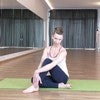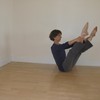Description
About This Video
Transcript
Read Full Transcript
Hi, I'm Ruth Alpert, and today we're going to talk about feet. Um, are really fun and really interesting and yes, you can live without feet, but you can also live much more nicely with feet that are alive in tuned in. Um, many of us in the, especially in this culture, we put our feet in shoes and socks and bedroom slippers and we keep our feet completely. Uh, and that's the ties in a way. And, uh, also on plots anytime if you're interested. Philip Beach has phenomenal work and theories and interesting, um, thinking about feet and I encourage you to go check him out.
His workshops are phenomenal, but he talks shoes. He often says that shoes and socks are sensory deprivation chambers for your feet. And I truly believe that. So a lot of what we're gonna be doing in these tutorials is getting your feet to wake up and start acting like feet again instead of cement blocks. So why, why feet? What's so important about them? You can live in a wheelchair without fee. Um, so what's the use of them and my image for this? Well, I have a few things, images for, for, or ways of talking about this. If you think about it, we're vertical creatures who are upright.
So the souls of our feet is the only part of us actually touching the planet when we're standing up. The rest of us were levitating or like in the air. It's, and then you think about the sole of your foot is this tiny surface. If you have an arch, you're not even flatfooted down. Think about how big this is. Think about how big this is or how big this is, right in r and these huge surfaces are not on the planet.
It's just this narrow part of the sole of your foot. And, and it's a huge piece of literally helping us feel grounded and connected. Um, the other part of feet is that each foot has 26 bones. And we'll talk about that more in a moment. But your feet are, I don't know if you all know the image of the waiter. This is an old cartoon of, you know, there's very formal waiter and he's got this stack of dishes and the dishes go like, I don't know, there is friend me a hundred dishes and he's holding the dishes and he's trying to walk and not like have them all crashed over. And that's my image for your feet, right?
Your feet are down there and the reason you have so many bones is that you're constantly having to adjust to what head wants to do, right? So your head sees something that it goes off this way or your arm has to pick something up and your feet are on the bottom goal. Oh my goodness. Where she go next? Okay, you got that one. Cuneiform. Okay. Cuboid. Come in now. You know, and it's constantly adjusting to deal with what's going on up here. I'm a perfect example of this as if you ever were for, I don't know, men maybe have, well, doc Martens platform shoes if you're of my generation. Uh, the old fashion Olaf daughter clogs when clogs first. Okay, here I am.
Another anecdote in the 1970s clogs arrived in the United States. They weren't made by Olaf daughters, O l a f and it was the new hip thing. And of course I had to have a pair and they were wooden. They were true wooden with leather top. And when you walked on gravel in wooden clogs, it was, it was like outward bound.
Like you could barely make it without falling over it because it's a solid platform and it has no given no adaptability to different surfaces. And that's the point of your feet. The point of having so many bones is that you're constantly adjusting and constantly rebalancing, um, to literally to stay upright. Now the value of being an upright creature, that's a whole nother discussion. I think if we were still on all fours, we would have much less back trouble.
We'd probably be much more functional. But on the other hand, there'd be, you know, we'd be eating off the ground. So let's not go there. But we are upright, so we have feet. So these feet are designed in such a way. I'm going to pull our skeleton over so you can actually see these bones. Um, we have yet to name him. So if you have any great ideas, you can, um, put it in the comments section under this and we're gonna move him into the center. I like calling him Jack Joe plotting his brother, cause you know he still has the barrel chest, Anil.
And just so he doesn't do anything lewd, we're going to get his arm out of the way cause he's of the [inaudible] family. So you know what they were like. Okay. So here's the foot, 26 bones, right? You a third of all the bones in your body are in your feet. Two leg bones, uh, lower leg bones, one upper leg bone, 26 in each foot, which is [inaudible]. And every time a bone meets another bone, that's a joint. So that's a possibility for movement.
So you can look this up. Nay. You know, bones get named so that when surgeons cut on them, they all agree they're in the same place. You can name come up with your own names, names, or just names. And once you lose your memory, you lose the name anyway. So who cares what you call it. But there are technical names for these phones. Um, uh, the toes here are called the Phalanges.
These long bones are called the metatarsal cells. Uh, the, let's see, maybe we can turn this way, the heel bonus that cal canus the outside. Now this outside bone is the cuboid, the navicular, the Talus is what your ankle sits on. And then you have the triplets, the cuneiform triplets. It's sort of like in the Mikado, you know, three little maids from school. Are we, um, all three of these are called the cuneiforms.
Um, what's very interesting in what a lot of people don't realize is how big your heel is. As my Alexander teacher, Robyn Avalon used to say, we learned our anatomy from Barbie and Ken in America. And so most people think that their foot is an l shape, right? That the heel goes down and the foot goes forward. But actually your ankle is coming into the center and you have heel in back as much as of rest of bones and in the front. And the ankle. The Tibia and fibula fit around the talus. It's often called a saddle joint so it can move this way.
There's a little tiny movement side to side, which he doesn't have cause he's got screws. Um, but there's some movement this way and we'll work with that in a bit. In the Alexander School of thought, what I, how I was trained is that the toes are actually an appendage. And when I first heard that, that was really news to me. But it's a very interesting way of thinking about the foot. So if you took the toes off, the foot would be this part and your arch really is the center of your foot.
A lot of what happens in plots is that when we do foot work on the reformer and you'd go to arches, people think the arch is the center of the long arch. And so they go to do foot work and put the bar right here, which is pretty literally right in the middle of the metatarsal bones, which are straight bones. They don't bend. Right. But if you put the bar where the pressure is right through the keystone arch here, you'll get a spring, you'll get a sense of spring, and uh, I'm going to demonstrate that in a moment, but that's really important that the center of your, your true anatomical art is literally
If I press on her foot right in this anatomical arch, which is right, I guess my hand is covering her, which is right about there. And I press, you can see movement all the way through the bones of her legs, right up to her hip socket, right? That's giving information straight up her body. Yeah. There it goes. If I elevate her like she's, I'm actually on relaxed moment. Yeah, give me the weight of your leg. She's on the reformer, right? So her legs are actually a little higher. Look at how much movement there is. Now, if I go to her center, ver in step, which is where everybody wants or was trained to do arches, which is actually right in the middle of the metatarsal bones, nothing happens.
And Eliza and I were playing with this earlier and we both realized the sensation is huge, way bigger than it shows. So if you do this with your colleagues or your clients, just know that the feeling or have somebody do this to you so you can really feel it because, and yet she's hyper extended, but it doesn't matter for this. It's going don't get on my case about correcting or hyper extension right now. Thank you very much. Um, it's still going through the bones, right? Good. So that's really crucial when you're on foot work or lakes and straps, right? You want the strap on the Cadillac or on the cattle or the reformer.
You want the strap also to give that information. Um, very often I see people put the strap up here and all that does is flex. Relax. Again, pressure here is just going to flex her ankle. It's not gonna send it right up her leg. Um, I'm sure there are other examples. So those are two that come to mind right now. Uh, but as you work with this [inaudible] the other piece to this too is that every reformer has the different size bars, different amount of padding. Um, Eve gentry's original machine that Joe made for her had a pipe. It was just a simple pipe with no padding.
So you could do bird feet and really wrap around the bar and you could get enormous, um, information and sensation from that. Nowadays, everything's so padded. So it could be that with the thicker, uh, the bounced bodies bars are really thick that you'll get a bigger surface covered. That's okay as long as you are getting the information right up through your arch. Um, you know, as long as that place is getting stimulated, it's okay have more surface area is also touching. Thanks Elisa, that was very helpful.
So I wanted to tell you just some really fun foot facts and I got these off by googling. So you know, it must be right. Um, one third of all the bones in the body are located in the feet. I mentioned that you have 26 bones, 33 joints, 19 muscles, 10 tendons, and the hundred and seven ligaments, which is why when you sprain your ankle or you sprain your foot, it's such an ordeal to heal from. Not to mention that you have enormous amounts of nerve endings in your feet and hands. But again, as I was saying before, not only do you have all these, uh, bones that are constantly in motion, adjusting in microscopic ways, you also have need that many nerve endings to give the information through your feet to your brain of where you are on the planet. And so when your feet are out of alignment, often, so is the rest of your body in utero. Um, feed in hand, start developing about the eighth week of pregnancy, even though at that point they're still webbed, but the arches don't develop until you're between two and three years old. And I imagine that's because that's when you start walking and you start the pressure and force going through your feet.
Um, the arches are there for a purpose and they're there for support. And I don't know if it's such a thing now, but I remember when I was younger, if you had flat feet, you weren't accepted into the army. You know, that flat feet really is a structural, um, has structural consequences. Let's put it that way. Here's a fun one. Human feet have more sweat glands than any other part of the body. Roughly 125,000 sweat glands per foot. Yes, I think we all have experienced that. Uh, um hm. Uh, too.
So don't take your shoes off in a public train. Uh, two and a half inch high heel can increase the load on the forefoot by 75%, and that's only a two and a half inch heel. So think of those tango dancers in those really spike heels during an average day of walking. The total forces on your feet can total hundreds of hundreds of tons equaled to an average of a fully loaded cement trunk.
It must be right standing in one spot is far more tiring than walking because the demands are being made on the same few muscles for a longer length of time. I mean, that's pretty obvious and logical, but that's why standing still and also we're upright. Creatures are designed for walking, not for standing this way, where we're designed to be in opposition or one leg forward and back. And so standing still with your feet in alignment for a long time on all the muscles of your body are quite exhausting. Um, the pressure on the feet when running can be as much as four times the runners body weight and the average foot. This is a fun one.
The average foot gets two sizes longer when a person stands up. So never buy shoes sitting down. Um, and there are lots of more fun foot facts, which youtube can Google and find out. Uh, so thanks a lot.
Comments
Thanks for this tutorial. Love your sense of humor too!
Thank you
You need to be a subscriber to post a comment.
Please Log In or Create an Account to start your free trial.














